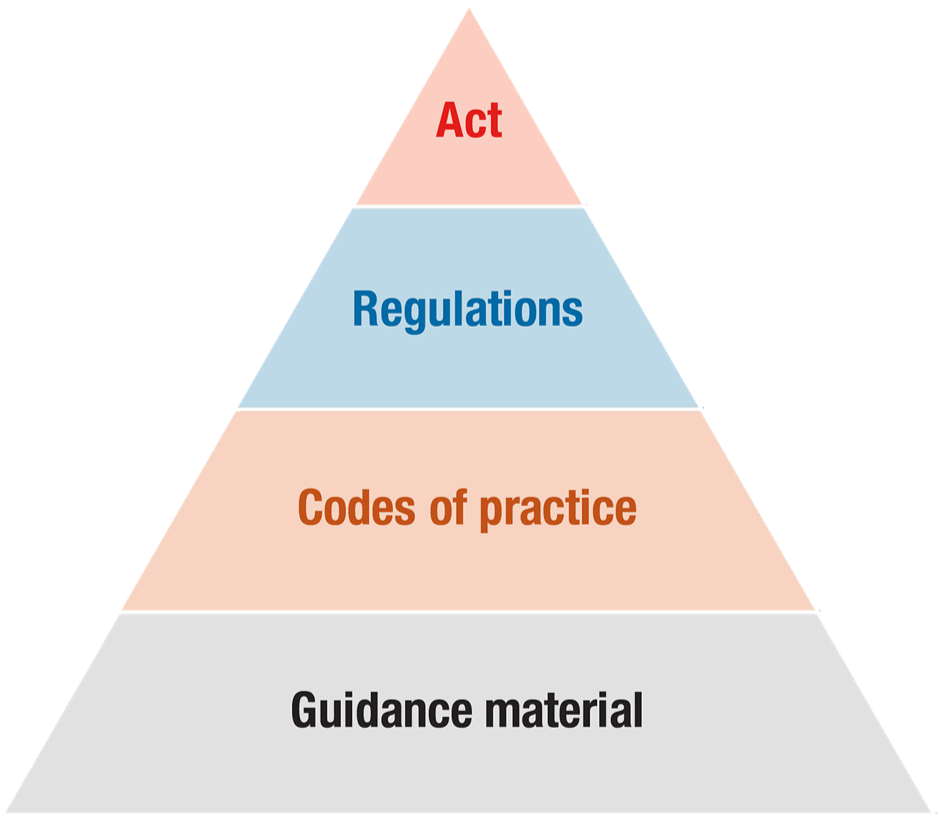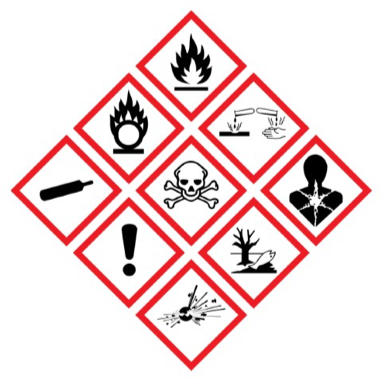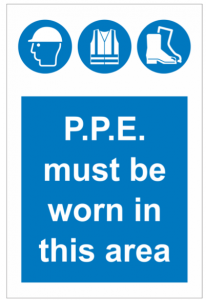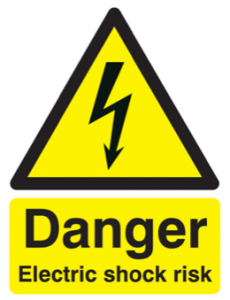10 Steps to Health and Safety - 2 Legal compliance

Compliance with the law
There is lots of health and safety legislation, with wide ranging impacts for organisations.
The main piece of legislation is the Health and Safety at Work Act etc. 1974 (HASAW). This allows for the creation of other regulations that are specific to control different workplace hazards.

Act
The Act is the formal, broad description of the law, setting out the key principles, duties, obligations and rights for each duty holder in relation to Health and Safety at Work. It includes the power to create regulations which are more specific to a particular activity.
An Act can only be amended by MPs sitting in Parliament.
Regulations
Regulations support the Act, providing more specific requirements about duties to control hazards, procedures and Health and Safety duties.
Regulations are still subject to parliamentary scrutiny, but more readily adaptable to changes or special circumstances than the Health and Safety at Work Act.
Approved Codes of Practice (ACoP)
Approved Codes of Practice (ACoP’s) provide guidance to operators to meet their ‘duty of care’ responsibilities.
Codes of practice are not legally binding but are admissible in Courts as evidence.
If duty holders choose not to follow a code of practice, they need to demonstrate what they are doing is a better system than that prescribed in the ACoP.
Guidance
Guidance is provided by various bodies including the H.S.E., insurance companies, trade bodies etc. and provide further guidance on how to comply with the duties under the Act and Regulation’s.
Guidance contributes to overall knowledge of hazards, risks and controls, so duty holders understand what is reasonably practicable, and duty holders can choose options that best suit their circumstances.
Health and Safety legislation
Health and Safety at Work Act 1974 (HASWA)
This is the main piece of legislation that protects people whilst at work.
The Health and Safety at Work Act. sets out and establishes, in law, that people have a right to a safe place of work with hazards properly controlled and managed.
The law sets out legal duties for employers, employees and the self-employed.
Management of Health and Safety at Work Regulations (MHSW)
Management of Health and Safety at Work Regulations 1999:require employers to carry out risk assessments, make arrangements to implement necessary measures, appoint competent people and arrange for appropriate information and training.

Control of Substances Hazardous to Health Regulations (COSHH)
Control of Substances Hazardous to Health Regulations 2002
(COSHH):require employers to assess the risks from hazardous substances and take appropriate precautions.
Lead and asbestos are not included within the COSHH Regulations as they have their own set of regulations.
The Health and Safety (Display Screen Equipment) Regulations
Health and Safety (Display Screen Equipment) Regulations 1992: set out requirements for work with Visual Display Units (VDUs).
VDU’s include computers, laptops, equipment control screens etc.
Employees must have a DSE workstation assessment and be provided with eye test to reduce the risks.
Noise at Work Regulations (NAWR)
Noise at Work Regulations 1989:require employers to take action to protect employees from hearing damage.
Noise can damage hearing and have a long-term health effect on an individual.
The regulations set out the need for specific actions to be taken as the ‘noise’ gets to certain levels.

The Control of Asbestos Regulations
The Control of Asbestos Regulations 2012:bring together a number of previous asbestos related regulations under one regulation. This sets out how those in control of buildings must protect people who could be exposed to asbestos.
Despite the use of asbestos being banned in 1999 asbestos still remains the biggest, work related, killer in the UK, killing approx. 4500 people per year in the UK.

Control of Lead at Work Regulations
The Control of Lead at Work Regulations 2002 (CLAW):place duties on employers to prevent workers to exposure to lead and where this can’t be prevented then the exposure must be controlled.
Lead can affect the long term health of individuals including:-
- Reduced liver function
- Effects on the nervous system
- Effect the testicles leading to infertility
- Change the blood leading to possible anaemia
Provision and Use of Work Equipment
Provision and Use of Work Equipment Regulations 1998:require that equipment provided for use at work, including machinery, is safe.
The regulations cover ALL work equipment included powered and manual equipment.
Personal Protective Equipment at Work Regulations |
|
|
Personal Protective Equipment at Work Regulations 1992:require employers to provide appropriate protective clothing and equipment for their employees. PPE only protects the individual so should only be considered when other controls can’t be applied or when hazards still remain. PPE must be provided by the employer and without cost to the employee. |
 PPE must be worn sign |
Chemicals (Hazard Information and Packaging) Regulations
Chemicals (Hazard Information and Packaging for Supply) Regulations 2002:require suppliers to classify, label and package dangerous chemicals and provide safety data sheets for them.
Manual Handling Operations Regulations
Manual Handling Operations Regulations 1992:cover the moving of objects by hand or bodily force.
As people are individuals with different capabilities, strengths, weaknesses etc. the assessment should be for that person.
Manual handling can have an immediate or long term affect on individuals.
Electricity at Work Regulations |
 Electric shock risk |
|
Electricity at Work Regulations 1989:require people in control of electrical systems to ensure they are safe to use and maintained in a safe condition. This ensures people are protected from coming into contact with live systems. |
Fire Precautions Act
The Regulatory Reform (Fire Safety) Order 2005:cover a wide range of fire safety requirements including:-
- Making an individual responsible for fire safety in an organisation
- Ensuring a fire assessment is undertaken
- Ensuring management controls are suitable to prevent a fire
- Emergency procedures should a situation occur
The Health and Safety (First-Aid) Regulations
Health and Safety (First Aid) Regulations 1981:cover requirements for first aid.
Workplace Health Safety and Welfare (WHSW) Regulations
Workplace (Health, Safety and Welfare) Regulations 1992:cover a wide range of basic health, safety and welfare issues such as ventilation, heating, lighting, workstations, seating and welfare facilities.
Reporting of Injuries, Diseases and Dangerous Occurrences Regulations
Reporting of Injuries, Diseases and Dangerous Occurrences Regulations 1995 (RIDDOR): require employers to notify certain occupational injuries, diseases and dangerous events.
Construction (Design and Management) Regulations 2015
Construction (Design and Management) Regulations 2015: cover construction safety.

The Construction Industry worker
The construction industry remains the most hazardous industry to work in and accounts for more deaths and long term health problems than any other industry in the UK.
The regulations cover all construction works including: -
- the construction, alteration, conversion, fitting out, commissioning, renovation, repair, upkeep, redecoration or other maintenance (including cleaning which involves the use of water or an abrasive at high pressure, or the use of corrosive or toxic substances), de-commissioning, demolition or dismantling of a structure;
- the preparation for an intended structure, including site clearance, exploration, investigation (but not site survey) and excavation (but not pre-construction archaeological investigations), and the clearance or preparation of the site or structure for use or occupation at its conclusion;
- the assembly on site of prefabricated elements to form a structure or the disassembly on site of the prefabricated elements which, immediately before such disassembly, formed a structure;
- the removal of a structure, or of any product or waste resulting from demolition or dismantling of a structure, or from disassembly of prefabricated elements which immediately before such disassembly formed such a structure;
- the installation, commissioning, maintenance, repair or removal of mechanical, electrical, gas, compressed air, hydraulic, telecommunications, computer or similar services which are normally fixed within or to a structure,
Taken from regulation 2, The Construction (Design and Management) Regulations 2015
The regulations cover a wide range of activities and place legal duties on various parties to ensure hazards are managed.
This is just some of the health and safety regulations that govern workplace activities.
 |
Find out the next step in the 10 steps to Health and Safety success - 3 Identify and manage risks |



0 Responses